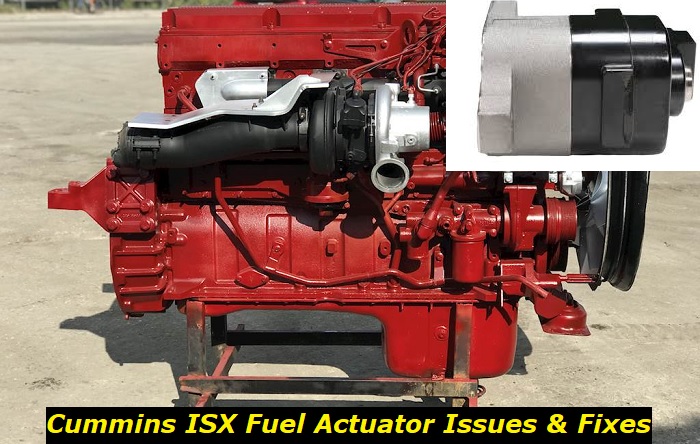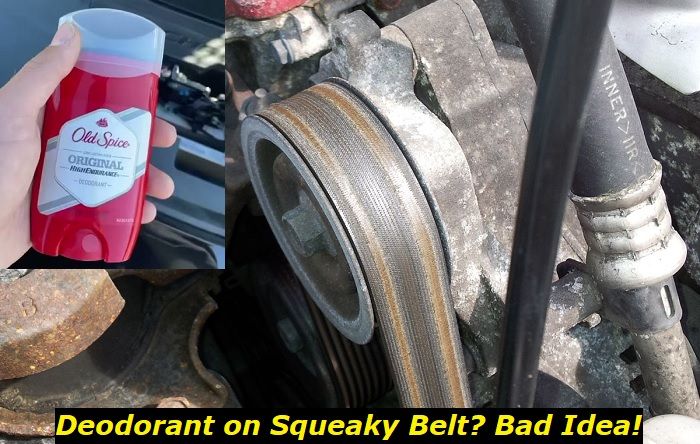The fuel actuator of the Cummins ISX engine plays a crucial role in the fuel and power management of your truck. So, when it's affected by a major problem, it could mean issues in your vehicle's overall performance, idle, fuel economy, and emissions, among others.
Diesel engine problems highlights
- Level of importance:Medium
- Commonreasons:Age and mileage, aggressive driving, poor maintenance
- DIY inspection:In most cases, impossible
- DIY repair:Impossible
- Price for repair:$650 - $1,500
- Can you drive?Depends on the issue
- Ways to fix:Replace the worn-out parts, professionalrepair is usually possible only

Failure Due to Fuel Contamination
Fuel contamination can lead to fuel actuator failure in the Cummins ISX due to a variety of reasons. One common cause is water intrusion, which happens when condensation builds up inside the fuel system and mixes with diesel fuel. This may be caused by inadequate maintenance or an aging seal on the injection pump, resulting in a decrease in performance or complete failure.
Another common reason is contamination from other sources such as engine oil, lubricants, and coolant entering into the diesel system. These contaminants are usually introduced during maintenance procedures when parts are changed out or if there is a malfunctioning component within the fuel system. In some cases, poor-quality fuel could also introduce contaminants that could put a strain on the Diesel Fuel Actuator (DFA).
To find the source of the problem, one should first observe the symptoms that may be present. These could include a decrease in engine performance, poor idle quality, or black smoke from the exhaust. Additionally, manual evaluation can help determine if there is any contamination within the fuel system by examining it for discoloration or smell. Lastly, tools can be used to measure pulse width and pressure levels to detect abnormal variations which could indicate fuel contamination.
The solution to this problem involves replacing damaged components that are causing fuel contamination as well as parts of the injection pump itself if they have been affected. This may involve installing new seals on valves, changing out contaminated injectors or filters, and replacing failed components.
Likewise, the fuel system should be flushed to remove any remaining contaminants and ensure that the actuator is running properly. Once all of these steps have been taken, quality diesel fuel should be used to avoid further issues with contamination.
It is important to note that prevention is key to avoiding fuel contamination and fuel actuator failure in the Cummins ISX engine. To do so, proper maintenance should take place at regular intervals as outlined in service manuals and best practices.
This includes regularly checking seals for leaks or damage, inspecting filters and injectors for debris, and replacing contaminated parts if necessary. Furthermore, one should always use high-quality diesel fuel to reduce the risk of introducing unwanted contaminants into the system. Doing so can help ensure that the fuel actuator runs smoothly and efficiently for many miles to come.
Broken Bolts in the Actuator
Broken bolts in the fuel actuator of a Cummins ISX can trigger serious issues with its performance. The most common causes of this problem are wear and tear on the bolts, damage due to vibration, or incorrect installation. If not addressed quickly, it can cause significant damage to the engine and other components throughout the vehicle.
To diagnose this issue, mechanics must first inspect for any visible signs of corrosion or failure which could indicate a broken bolt. Vibrations from engine operation can also be a sign that something is wrong with the fuel actuator so they should be monitored as well. The best way to determine if there is an issue is by using specialized tools such as multimeters, borescopes, or digital pressure gauges.
Once a broken bolt has been identified, the solution is to replace it. This can be done by removing the bolts and replacing them with new copper or chrome-plated steel ones. Care must be taken to ensure they are tightened properly, as too much force could damage the actuator further.
In addition, worn-out parts such as gaskets and O-rings should also be replaced to prevent any potential leaks in the system. As soon as these repairs have been made, mechanics should check for proper fuel flow and that all connections are secure before putting the vehicle back into service.
Timing Issues
Timing issues in the fuel actuator of the Cummins ISX can lead to serious problems for engine performance and efficiency. The most common causes of these timing issues are a faulty engine control unit (ECU), an incorrectly programmed ECU, or a disconnected turbo actuator wire. Other potential causes include debris buildup on the vanes, incorrect valve clearance, and improper timing belt tension.
In evaluating the root of the problem, it is important to observe symptoms such as decreased power output and irregular fuel injection. Manual check-ups should be done as well to ensure that components such as valves, intake manifold seals, and turbochargers are all properly adjusted and functioning correctly. Diagnostic tools such as oscilloscopes should also be used to further help determine the cause of the timing issues.
The solution for this type of problem will typically involve replacing parts such as the ECM, fuel injectors, and sensors. It may also be necessary to replace other components such as solenoids, guidance systems, and O-rings. In some cases, complete replacement of the entire actuator unit may be required.
To ensure optimal engine performance, it is important that repair work is done according to manufacturer specifications with properly calibrated and compatible parts. This can help reduce future problems related to the fuel actuator in Cummins ISX engines.
Finally, regular maintenance should be conducted to keep the system clean and free of debris. Proactive preventative measures such as these can help prolong engine life and save money on costly repairs in the long run.
Gasket Not Sealing
When the gasket of the fuel actuator is not sealing properly in the Cummins ISX, it can lead to some problems. These could include rough idling, engine misfiring, poor acceleration, and reduced overall engine performance. Additionally, the air-fuel mixture may be affected resulting in an increase in emissions and a decrease in fuel economy.
To quickly diagnose and fix this particular issue, you will need to carry out some manual inspections using relevant tools. The most common reasons for this fault are typically related to damaged or faulty parts such as worn hoses, clogged injectors, or leaking seals. Checking for any visible signs of damage on the fuel system components should be done first by removing the air inlet pipe and visually inspecting them.
If no visible signs of damage are found, then you should consult the service manual for instructions on how to perform a pressure test with a fuel pressure gauge. This will help identify any areas that have lost their seal or are not sealing properly.
Once the problem area has been identified, it can be fixed by replacing faulty parts such as worn hoses or leaking seals. Depending on the severity of the issue, it may require replacing additional components such as injectors or actuators. If necessary, you should also check for other faults related to this one before beginning repairs.
It is important to remember that when carrying out work on the fuel system, safety must be your primary concern. Carefully follow the instructions provided in the service manual and wear the necessary protective equipment. Always check for faulty wiring or worn parts before replacing any components as this will help to prevent further damage to the engine.
ECU Malfunction
ECU malfunction is one more cause of fuel actuator problems in the Cummins ISX. Unfortunately, ECU failure is a common issue as it controls many vital functions, such as engine performance and fuel efficiency. The most frequent reasons for an ECU to fail are wear and tear due to long-term use or improper maintenance; physical damage from extreme environmental conditions (e.g., humidity, dust); and system malfunctions due to glitches in the system.
The symptoms of ECU failure vary but may include a lack of power when accelerating, reduced engine speed while driving, and poor fuel economy if the truck has not been serviced recently. Visual checkups can help identify any underlying issues, however, professional diagnostic tools are usually necessary to determine the exact cause of the problem.
The best solution to an ECU failure is a reflash or reprogramming, which involves replacing faulty programming codes with improved software that enhances engine performance. If this does not work, then it may be necessary to replace some parts such as the wiring harness and fuel injectors. In extreme cases, all electronic components and modules within the system must be replaced.
It is important to keep in mind that ECU malfunctions can easily lead to other problems if not fixed properly on time.
Therefore, it is important for truck owners to get their vehicles regularly serviced by qualified mechanics and take any necessary steps quickly when a problem arises to avoid further damage. Vehicle owners should also consult their owner's manual or contact their truck manufacturer to ensure they are aware of the risks associated with ECU failure and how best to prevent them.
Conclusion
There are a lot of factors that can serve as precursors to potential problems with the fuel actuator of the Cummins ISX engine. The ones listed here are just the most common of them.
Nonetheless, no matter what is the cause of the actuator problem in your engine, it's always best to seek the assistance of a professional mechanic in the investigation and resolution of the issue.
About the authors
The CarAraC research team is composed of seasoned auto mechanics and automotive industry professionals, including individuals with advanced degrees and certifications in their field. Our team members boast prestigious credentials, reflecting their extensive knowledge and skills. These qualifications include: IMI: Institute of the Motor Industry, ASE-Certified Master Automobile Technicians; Coventry University, Graduate of MA in Automotive Journalism; Politecnico di Torino, Italy, MS Automotive Engineering; Ss. Cyril and Methodius University in Skopje, Mechanical University in Skopje; TOC Automotive College; DHA Suffa University, Department of Mechanical Engineering






Add comment